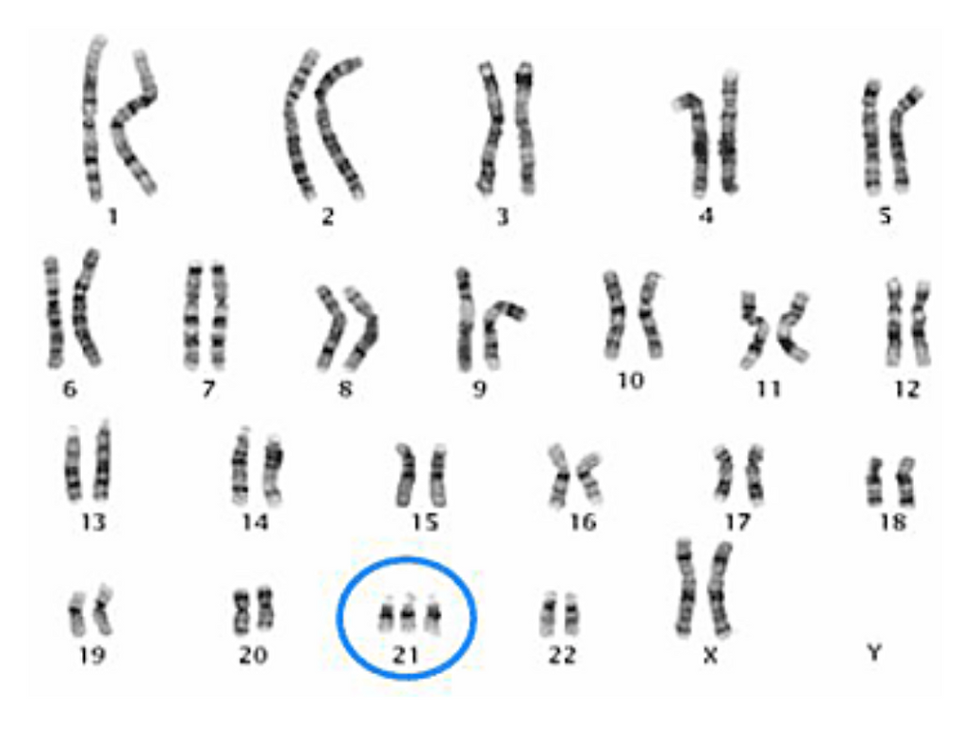Down syndrome is a genetic condition in which a person is born with an extra copy of chromosome 2. This means that they have 47 chromosomes instead of 46. This can affect how their brain and body develop. People diagnosed with Down syndrome have happy and healthy lives with supportive care.
Karyotype of an individual with Down Syndrome
What causes increased risk of Down Syndrome?
Studies suggest that the risk of giving birth to a child with Down Syndrome increases as the birthing parent ages. Women or people assigned female at birth who are 35 or older are more likely to have a child diagnosed with Down syndrome or another type of genetic condition.
How common is Down Syndrome?
Down syndrome is the most common chromosome-related condition in the United States. As estimated 6000 babies are born with the condition in the US every year, which equals about every 700 babies. There are about 200,000 people in the US diagnosed with Down Syndrome.
There are about 60-75 Down syndrome births every year in Singapore, and 50,000 births of individuals with Down syndrome in the world.
What are the physical signs of Down Syndrome?
Physical signs of Down syndrome are usually present at birth and become more apparent as a baby grows. They can include:
A flat nose bridge
Slanted eyes that point upward
A short neck
Small ears, hands and feet
Weak muscle tone at birth
Small pinky finger that point inwards towards the thumb
One crease in the palm of their hand
Shorter than average height
What are some cognitive disabilities faced by individuals with Down syndrome?
A child with Down syndrome faces cognitive development issues as a result of their extra chromosome. This can cause intellectual or developmental disabilities. The child’s ability to meet developmental milestones, or things that your child can do at a certain age, may differ from other children, including how they:
Walk and move (gross and fine motor skills)
Speak (language development skills)
Learn (cognitive skills)
Play (social and emotional skills)
How is Down syndrome diagnosed?
Down syndrome can be diagnosed before birth with prenatal screening tests, diagnostic tests during pregnancy, and karyotype tests after birth.
Prenatal screening tests such as ultrasounds and blood tests of the birthing parent’s blood assess the risk of a child having Down Syndrome. During ultrasound examinations, signs such as extra fluid behind the baby’s neck point toward Down Syndrome.
After a screening test, diagnostic tests such as Amniocentesis (a test using amniotic fluid) and Chorionic villus sampling (a test using a small sample of cells from the placenta) can be carried out to detect chromosomal changes that lead to a Down Syndrome diagnosis.
To find out more about amniocentesis, refer to this link: https://my.clevelandclinic.org/health/diagnostics/4206-genetic-amniocentesis
To find out more about Chorionic villus sampling, refer to this link:
Karyotype testing is carried out in children who are born and suspected to have Down Syndrome. The healthcare provider will remove a small blood sample to study under a microscope. They look for an extra chromosome 21 to diagnose the condition.
How is Down Syndrome treated?
Although there is no cure for Down Syndrome, treatment is available to help children reach their full potential. Treatment focuses primarily on helping the child reach their developmental goals. Treatment options include:
physical or occupational therapy
Speech therapy
Participating in special education programs in school
Treating any underlying medical condition
Wearing glasses for vision problems or assisted hearing aids for hearing loss.
Reference List
Clinic, C. (2023). Down Syndrome: Symptoms & Causes. [online] Cleveland Clinic. Available at: https://my.clevelandclinic.org/health/diseases/17818-down-syndrome#overview.
Dallas (2014). Down Syndrome Guild of Dallas. [online] Down Syndrome Guild of Dallas. Available at: https://www.downsyndromedallas.org/about-down-syndrome-1.
.png)


Comments